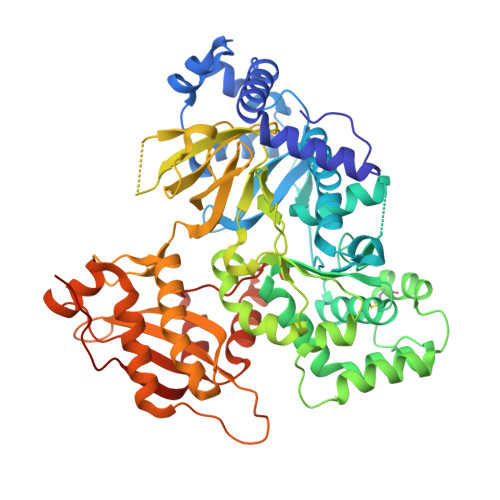Modification of auxinic phenoxyalkanoic acid herbicides by the acyl acid amido synthetase GH3.15 from Arabidopsis.
Sherp, A.M., Lee, S.G., Schraft, E., Jez, J.M.(2018) J Biol Chem 293: 17731-17738
- PubMed: 30315112
- DOI: https://doi.org/10.1074/jbc.RA118.004975
- Primary Citation of Related Structures:
6E1Q - PubMed Abstract:
Herbicide-resistance traits are the most widely used agriculture biotechnology products. Yet, to maintain their effectiveness and to mitigate selection of herbicide-resistant weeds, the discovery of new resistance traits that use different chemical modes of action is essential. In plants, the Gretchen Hagen 3 (GH3) acyl acid amido synthetases catalyze the conjugation of amino acids to jasmonate and auxin phytohormones. This reaction chemistry has not been explored as a possible approach for herbicide modification and inactivation. Here, we examined a set of Arabidopsis GH3 proteins that use the auxins indole-3-acetic acid (IAA) and indole-3-butyric acid (IBA) as substrates along with the corresponding auxinic phenoxyalkanoic acid herbicides 2,4-dichlorophenoxylacetic acid (2,4-D) and 4-(2,4-dichlorophenoxy)butyric acid (2,4-DB). The IBA-specific AtGH3.15 protein displayed high catalytic activity with 2,4-DB, which was comparable to its activity with IBA. Screening of phenoxyalkanoic and phenylalkyl acids indicated that side-chain length of alkanoic and alkyl acids is a key feature of AtGH3.15's substrate preference. The X-ray crystal structure of the AtGH3.15·2,4-DB complex revealed how the herbicide binds in the active site. In root elongation assays, Arabidopsis AtGH3.15-knockout and -overexpression lines grown in the presence of 2,4-DB exhibited hypersensitivity and tolerance, respectively, indicating that the AtGH3.15-catalyzed modification inactivates 2,4-DB. These findings suggest a potential use for AtGH3.15, and perhaps other GH3 proteins, as herbicide-modifying enzymes that employ a mode of action different from those of currently available herbicide-resistance traits.
Organizational Affiliation:
From the Department of Biology, Washington University, St. Louis, Missouri 63130.
















